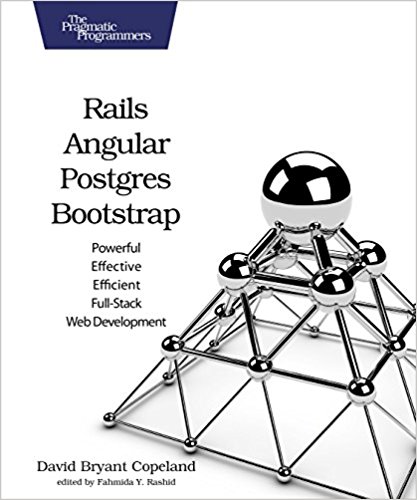A Comprehensive Guide to Building Modern Web Applications with Rails, Angular, PostgreSQL, and Bootstrap
Introduction
This white paper explores the synergy of Ruby on Rails, Angular, PostgreSQL, and Bootstrap in building robust, scalable, and user-friendly web applications. We will delve into the core concepts, advantages, and best practices associated with each technology, along with practical examples to illustrate their integration.
Ruby on Rails: The Backbone of Server-Side Development
Core Concepts:
- Model-View-Controller (MVC) Architecture: Separates concerns into models, views, and controllers.
- Convention over Configuration: Reduces boilerplate code and accelerates development.
- Active Record: Provides an object-relational mapping (ORM) layer for interacting with databases.
- Action Pack: Handles routing, controller actions, and view rendering.
Advantages:
- Rapid Development: Accelerates development time with built-in features and conventions.
- Strong Community and Ecosystem: Benefits from a large and active community and a wealth of libraries and frameworks.
- Security: Built-in security features protect against common vulnerabilities.
- Scalability: Can handle high traffic loads and scale horizontally.
Angular: The Frontend Framework
Core Concepts:
- Component-Based Architecture: Breaks down the UI into reusable components.
- Two-Way Data Binding: Synchronizes data between the model and the view.
- Dependency Injection: Manages dependencies and promotes modularity.
- Routing: Handles navigation between different views.
Advantages:
- Rich Feature Set: Provides a wide range of features for building complex web applications.
- Performance: Offers high performance and responsiveness.
- Cross-Platform Compatibility: Can be used to build web, mobile, and desktop applications.
- Strong Community and Ecosystem: Benefits from a large and active community and a wealth of libraries and tools.
PostgreSQL: The Reliable Database
Key Features:
- ACID Compliance: Ensures data integrity and consistency.
- High Performance: Handles large datasets and complex queries efficiently.
- Advanced Features: Supports advanced features like full-text search, JSONB data type, and time-series data.
- Open-Source: Free to use and highly customizable.
Advantages:
- Scalability: Can scale to handle large-scale applications.
- Reliability: Offers robust data integrity and recovery mechanisms.
- Flexibility: Supports a wide range of data types and complex queries.
- Strong Community: Benefits from a large and active community.
Bootstrap: The Front-End Framework
Core Features:
- Responsive Design: Automatically adapts to different screen sizes.
- Pre-built Components: Provides a collection of pre-built UI components like buttons, forms, and navigation bars.
- CSS Framework: Offers a comprehensive CSS framework for styling web pages.
- JavaScript Plugins: Includes JavaScript plugins for features like modal windows, tooltips, and carousels.
Advantages:
- Rapid Prototyping: Accelerates development with pre-built components.
- Cross-Browser Compatibility: Ensures consistent rendering across different browsers.
- Mobile-First Design: Prioritizes mobile-friendly design.
- Customizability: Highly customizable to fit specific design needs.
Integrating the Stack
Backend:
- Rails API: Create a Rails API to handle data operations and business logic.
- PostgreSQL: Store and retrieve data efficiently.
- Authentication and Authorization: Implement robust authentication and authorization mechanisms.
- API Design: Design RESTful APIs to expose data to the frontend.
Frontend:
- Angular Application: Build a single-page application (SPA) using Angular.
- Frontend Components: Create reusable components for different parts of the UI.
- Data Fetching: Use Angular's HTTP client to fetch data from the Rails API.
- State Management: Manage application state using tools like NgRx or Redux.
- UI Design: Use Bootstrap to create a visually appealing and responsive user interface.
Best Practices
- Code Quality and Maintainability: Follow coding standards, write clean and well-documented code, and use version control.
- Testing: Implement unit, integration, and end-to-end tests to ensure code quality.
- Security: Protect against vulnerabilities like SQL injection, cross-site scripting, and cross-site request forgery.
- Performance Optimization: Optimize database queries, minimize network requests, and leverage caching techniques.
- Deployment: Use tools like Capistrano or Docker for efficient deployment.
By effectively combining Rails, Angular, PostgreSQL, and Bootstrap, you can build powerful, scalable, and user-friendly web applications.
References:
- Ruby on Rails Guides: https://v2.angular.io/
- PostgreSQL Documentation: https://getbootstrap.com/
- Effective Ruby on Rails: https://www.amazon.com/Angular-Action-Jeremy-Wilken/dp/1617293318
- PostgreSQL High Performance Cookbook: https://www.linkedin.com/learning/topics/bootstrap
By following these guidelines and leveraging the powerful tools provided by this technology stack, you can create exceptional web applications that delight users and drive business success.



